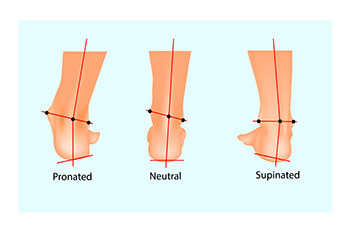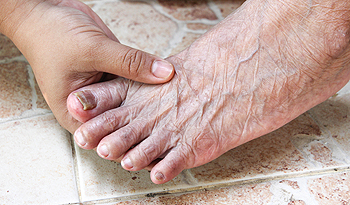
Overpronation occurs when the arches of the feet roll inward excessively while walking or running. This condition, also known as flat feet or pes planus, can lead to improper alignment and increased pressure on the lower body. People with overpronation may experience pain in the feet, ankles, knees, or hips, especially during high-impact activities. Common causes of overpronation include a naturally flexible arch, obesity, injury, or certain medical conditions that affect the foot's structure. Left untreated, overpronation can increase the risk of stress fractures, shin splints, and tendonitis. A podiatrist can evaluate your gait and recommend a variety of treatments. Included are custom orthotics, choosing more supportive footwear, or recommending specific exercises to strengthen the foot muscles and improve alignment. These solutions can help reduce discomfort and prevent further injury. If you have problems with overpronation, it is suggested that you schedule an appointment with a podiatrist for an exam and diagnosis.
If you have any concerns about your feet, contact Dr. Richard DiMario from Maine. Our doctor can provide the care you need to keep you pain-free and on your feet.
Biomechanics in Podiatry
Podiatric biomechanics is a particular sector of specialty podiatry with licensed practitioners who are trained to diagnose and treat conditions affecting the foot, ankle and lower leg. Biomechanics deals with the forces that act against the body, causing an interference with the biological structures. It focuses on the movement of the ankle, the foot and the forces that interact with them.
A History of Biomechanics
Modern technological improvements are based on past theories and therapeutic processes that provide a better understanding of podiatric concepts for biomechanics. Computers can provide accurate information about the forces and patterns of the feet and lower legs.
Understanding biomechanics of the feet can help improve and eliminate pain, stopping further stress to the foot.
If you have any questions please feel free to contact our office located in York, ME . We offer the newest diagnostic and treatment technologies for all your foot and ankle needs.

Onychomycosis and other superficial fungal infections are common among the elderly, particularly affecting the feet. Onychomycosis is a fungal infection of the toenails that cause the nails to become thickened, discolored, brittle, and sometimes painful. Aging, decreased circulation, and a weakened immune system make seniors more susceptible to these infections. Athlete's foot, another fungal infection, can cause itching, redness, and peeling between the toes and on the soles. Fungal infections thrive in warm, moist environments, like the inside of shoes. These infections can be slow to resolve without proper treatment, and in seniors, they may lead to more severe complications especially those with diabetes or compromised circulation. Proper foot hygiene and wearing breathable footwear can help prevent such infections. If you are elderly and are experiencing fungal infections on your feet, it is suggested that you visit a podiatrist for treatment to prevent these infections from worsening.
If left untreated, toenail fungus may spread to other toenails, skin, or even fingernails. If you suspect you have toenail fungus it is important to seek treatment right away. For more information about treatment, contact Dr. Richard DiMario of Maine. Our doctor can provide the care you need to keep you pain-free and on your feet.
Symptoms
Treatment
If self-care strategies and over-the-counter medications does not help your fungus, your podiatrist may give you a prescription drug instead. Even if you find relief from your toenail fungus symptoms, you may experience a repeat infection in the future.
Prevention
In order to prevent getting toenail fungus in the future, you should always make sure to wash your feet with soap and water. After washing, it is important to dry your feet thoroughly especially in between the toes. When trimming your toenails, be sure to trim straight across instead of in a rounded shape. It is crucial not to cover up discolored nails with nail polish because that will prevent your nail from being able to “breathe”.
In some cases, surgical procedure may be needed to remove the toenail fungus. Consult with your podiatrist about the best treatment options for your case of toenail fungus.
If you have any questions, please feel free to contact our office located in York, ME . We offer the newest diagnostic and treatment technologies for all your foot care needs.

Diabetic foot ulcers are a significant risk for people with diabetes, often leading to severe complications if not properly managed. These ulcers are open sores or wounds that usually occur on the bottom of the feet, caused by a combination of poor circulation and nerve damage, common in diabetic patients. Prevention is key in managing this risk. Daily foot inspections, maintaining proper foot hygiene, and wearing well-fitted shoes can help prevent ulcers. Managing blood sugar levels also plays a vital role in prevention. For those who develop foot ulcers, early treatment is critical. This includes cleaning and dressing the wound, controlling infection, and using custom orthotics or special footwear to alleviate pressure on the affected area. In more severe cases, surgical interventions may be necessary. If you have diabetes, and develop a foot ulcer, it is strongly suggested that you include a podiatrist on your health care team for routine care of your feet.
Wound care is an important part in dealing with diabetes. If you have diabetes and a foot wound or would like more information about wound care for diabetics, consult with Dr. Richard DiMario from Maine. Our doctor will assess your condition and provide you with quality foot and ankle treatment.
What Is Wound Care?
Wound care is the practice of taking proper care of a wound. This can range from the smallest to the largest of wounds. While everyone can benefit from proper wound care, it is much more important for diabetics. Diabetics often suffer from poor blood circulation which causes wounds to heal much slower than they would in a non-diabetic.
What Is the Importance of Wound Care?
While it may not seem apparent with small ulcers on the foot, for diabetics, any size ulcer can become infected. Diabetics often also suffer from neuropathy, or nerve loss. This means they might not even feel when they have an ulcer on their foot. If the wound becomes severely infected, amputation may be necessary. Therefore, it is of the upmost importance to properly care for any and all foot wounds.
How to Care for Wounds
The best way to care for foot wounds is to prevent them. For diabetics, this means daily inspections of the feet for any signs of abnormalities or ulcers. It is also recommended to see a podiatrist several times a year for a foot inspection. If you do have an ulcer, run the wound under water to clear dirt from the wound; then apply antibiotic ointment to the wound and cover with a bandage. Bandages should be changed daily and keeping pressure off the wound is smart. It is advised to see a podiatrist, who can keep an eye on it.
If you have any questions, please feel free to contact our office located in York, ME . We offer the newest diagnostic and treatment technologies for all your foot care needs.

Hammertoes are a deformity where one or more toes become bent at the middle joint, resembling a hammer. This condition often affects the second, third, or fourth toes and can lead to pain, stiffness, and difficulty wearing shoes. Common symptoms include visible toe bending, discomfort, corns or calluses from friction with footwear, and limited range of motion in the affected toes. Hammertoes develop due to muscle imbalances in the foot, often caused by wearing tight or ill-fitting shoes, injury, or conditions like arthritis or diabetes. Left untreated, hammertoes can worsen, leading to complications such as open sores, infections, or permanent joint damage. Treatment options vary depending on severity, from conservative approaches such as wearing roomier shoes to surgical correction in more advanced cases. If you have a hammertoe, it is suggested that you visit a podiatrist as early intervention can alleviate discomfort and prevent further deformity.
Hammertoe
Hammertoes can be a painful condition to live with. For more information, contact Dr. Richard DiMario from Maine. Our doctor will answer any of your foot- and ankle-related questions.
Hammertoe is a foot deformity that affects the joints of the second, third, fourth, or fifth toes of your feet. It is a painful foot condition in which these toes curl and arch up, which can often lead to pain when wearing footwear.
Symptoms
Causes
Genetics – People who are genetically predisposed to hammertoe are often more susceptible
Arthritis – Because arthritis affects the joints in your toes, further deformities stemming from arthritis can occur
Trauma – Direct trauma to the toes could potentially lead to hammertoe
Ill-fitting shoes – Undue pressure on the front of the toes from ill-fitting shoes can potentially lead to the development of hammertoe
Treatment
Orthotics – Custom made inserts can be used to help relieve pressure placed on the toes and therefore relieve some of the pain associated with it
Medications – Oral medications such as anti-inflammatories or NSAIDs could be used to treat the pain and inflammation hammertoes causes. Injections of corticosteroids are also sometimes used
Surgery – In more severe cases where the hammertoes have become more rigid, foot surgery is a potential option
If you have any questions please contact our office located in York, ME . We offer the newest diagnostic and treatment technologies for all your foot and ankle needs.

Pediatric foot and ankle pain can arise from various factors, including skeletal maturity, minor trauma, repetitive stress, and abnormal biomechanics. As children grow, their bones and joints are still developing, which can sometimes lead to discomfort or pain due to changes in skeletal maturity. Minor trauma, such as a twist or bump, can also result in localized pain. Repetitive stress from activities like running or sports can strain growing tissues and cause discomfort. Abnormal biomechanics, including issues like flat feet or improper foot alignment, can contribute to chronic pain and discomfort. Addressing these causes with appropriate interventions, such as proper footwear and medical evaluation, is essential for managing symptoms. If your child has foot or ankle pain, it is suggested that you consult a podiatrist who can diagnose the cause and offer effective treatment solutions.
Foot Pain
Foot pain can be extremely painful and debilitating. If you have a foot pain, consult with Dr. Richard DiMario from Maine. Our doctor will assess your condition and provide you with quality foot and ankle treatment.
Causes
Foot pain is a very broad condition that could be caused by one or more ailments. The most common include:
Diagnosis
To figure out the cause of foot pain, podiatrists utilize several different methods. This can range from simple visual inspections and sensation tests to X-rays and MRI scans. Prior medical history, family medical history, and any recent physical traumatic events will all be taken into consideration for a proper diagnosis.
Treatment
Treatment depends upon the cause of the foot pain. Whether it is resting, staying off the foot, or having surgery; podiatrists have a number of treatment options available for foot pain.
If you have any questions, please feel free to contact our office located in York, ME . We offer the newest diagnostic and treatment technologies for all your foot care needs.